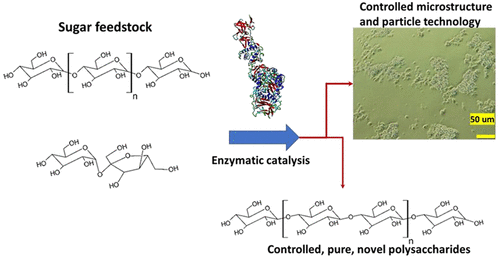当前位置:
X-MOL 学术
›
ACS Sustain. Chem. Eng.
›
论文详情
Our official English website, www.x-mol.net, welcomes your
feedback! (Note: you will need to create a separate account there.)
Enzymatic Polymerization Routes to Synthetic–Natural Materials: A Review
ACS Sustainable Chemistry & Engineering ( IF 7.1 ) Pub Date : 2020-06-12 , DOI: 10.1021/acssuschemeng.0c01664 Natnael Behabtu 1 , Slavko Kralj 1
ACS Sustainable Chemistry & Engineering ( IF 7.1 ) Pub Date : 2020-06-12 , DOI: 10.1021/acssuschemeng.0c01664 Natnael Behabtu 1 , Slavko Kralj 1
Affiliation

|
Sustainability is becoming a key driver for product differentiation, and corporations around the world are setting specific sustainability metrics on new products. Greenhouse gas emissions (GHG), land and water use, renewable feedstocks, and product end-of-life are thus becoming the metrics to assess products for environmental and societal impact. Within this framework, current commercial polymeric materials are showing their limitations and warranting the need for novel material development. A new emphasis on natural materials with the design flexibility of synthetic material is emerging to address these needs. Polysaccharides are a class of natural polymers that need a renewed focus given their large design space and rich functionality combined with intrinsic sustainability. Yet, being mostly extracted from natural feedstock, current industrial polysaccharides such as cellulose and starch lack the purity and molecular design precision found in synthetic polymers. Enzymatic polymerization of polysaccharides is one technology that can address some of the current limitations, allowing synthetic polymerization approaches. This technology enables both the synthesis of known polysaccharides with a higher purity and polymer structure precision as well as the synthesis of hard to extract polysaccharides such as alpha-1,3-glucans. Moreover, the bottom-up assembly of insoluble polysaccharide polymers from soluble monomers allows the design of novel and rich colloidal features which, in turn, enable many industrial applications. Thus, enzymatic polymerization offers the potential to meet the purity and control offered by synthetic polymeric materials while meeting, by design, the ever more stringent end-of-life requirements.
中文翻译:

酶促聚合途径合成天然材料的研究进展
可持续发展正成为产品差异化的关键驱动力,世界各地的企业都在为新产品设定特定的可持续性指标。因此,温室气体排放(GHG),土地和水的使用,可再生原料以及产品报废已经成为评估产品对环境和社会影响的指标。在此框架内,当前的商业聚合物材料正显示出其局限性,并保证需要开发新颖的材料。为了满足这些需求,对天然材料的新的强调以及合成材料的设计灵活性正在出现。多糖是一类天然聚合物,鉴于其较大的设计空间和丰富的功能以及固有的可持续性,因此需要重新关注。但是,由于大部分是从天然原料中提取的,当前的工业多糖如纤维素和淀粉缺乏合成聚合物中发现的纯度和分子设计精度。多糖的酶促聚合是一种可以解决当前某些局限性的技术,允许合成聚合方法。该技术既可以合成具有更高纯度和聚合物结构精度的已知多糖,也可以合成难以提取的多糖,例如α-1,3-葡聚糖。此外,由可溶性单体自下而上地组装不溶性多糖聚合物允许设计新颖和丰富的胶体特征,这反过来又使许多工业应用成为可能。因此,酶促聚合可满足合成聚合物材料提供的纯度和控制要求,同时通过设计满足以下要求:
更新日期:2020-07-13
中文翻译:

酶促聚合途径合成天然材料的研究进展
可持续发展正成为产品差异化的关键驱动力,世界各地的企业都在为新产品设定特定的可持续性指标。因此,温室气体排放(GHG),土地和水的使用,可再生原料以及产品报废已经成为评估产品对环境和社会影响的指标。在此框架内,当前的商业聚合物材料正显示出其局限性,并保证需要开发新颖的材料。为了满足这些需求,对天然材料的新的强调以及合成材料的设计灵活性正在出现。多糖是一类天然聚合物,鉴于其较大的设计空间和丰富的功能以及固有的可持续性,因此需要重新关注。但是,由于大部分是从天然原料中提取的,当前的工业多糖如纤维素和淀粉缺乏合成聚合物中发现的纯度和分子设计精度。多糖的酶促聚合是一种可以解决当前某些局限性的技术,允许合成聚合方法。该技术既可以合成具有更高纯度和聚合物结构精度的已知多糖,也可以合成难以提取的多糖,例如α-1,3-葡聚糖。此外,由可溶性单体自下而上地组装不溶性多糖聚合物允许设计新颖和丰富的胶体特征,这反过来又使许多工业应用成为可能。因此,酶促聚合可满足合成聚合物材料提供的纯度和控制要求,同时通过设计满足以下要求:




















































 京公网安备 11010802027423号
京公网安备 11010802027423号